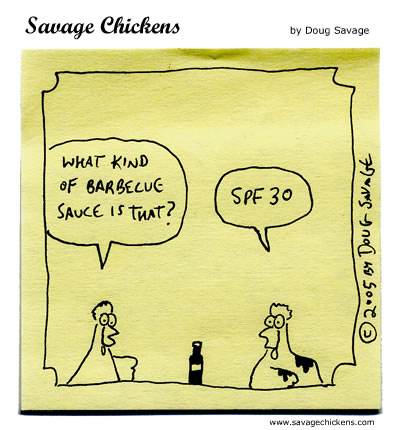 |
|
Newsletter 7 :: 06/01/2012
Sunshine helps
prevent skin cancer while sunscreens promote it
Tuesday, December 27, 2011 by: Paul Fass
There
are three types of skin cancer - of which melanoma is the most dangerous and
potentially lethal because it can metastasize into other body parts. The other
two non-melanoma types, squamous cell carcinoma and basal cell carcinoma, are
treatable and not as threatening or able to metastasize as melanoma.
Most skin cancer cases are of the basal cell carcinoma type, which can destroy
surrounding tissue and disfigure facial skin areas if unchecked. It is advisable
to check with a dermatologist if you have any unusual new moles or sores that
won't heal anywhere on your skin. Skin biopsies are easy to perform.
Mainstream medicine blames the sun for all three types, and recommends sun
screen lotions to block sun exposure. But one should take their sloppy science
of prevention with several grains of salt.
Just about any dermatologist
still holds to the myth that you need to avoid direct sunlight or lather your
body with sunscreen to avoid skin cancer. Recently, the opposite has been
determined to be true in both cases.
Sloppy science that harms more than helps
There
are two basic types of ultra-violet (UV) rays from the sun that affect us: UVA
and UVB. Ultra-violet A (UVA) rays have little or no benefit, and can cause
some skin damage that initially shows as sunburn and eventually dries and ages
the skin. UVA rays are steady throughout the day. Most sunscreens do not block
harmful UVA rays. But most of them contain toxic and carcinogenic
ingredients.
Natural lotions and many European sunscreens are more
beneficial and less toxic. This requires some serious label reading. Simply
using coconut oil, sunflower oil, jojoba (hoHOba) oil, eucalyptus oil, or shea
butter is easier for preventing sun burn if you're concerned.
Glass
windows and windshields do not filter out UVA rays. But they do manage to block
UVB rays. UVB rays are involved with the beginning of a body's vitamin D3
production. And UVB rays peak during mid-day and are strongest during summers
and nearer the equator. They are not the same throughout the day as UVA rays
are.
So the sloppy science says you must deprive yourself of sun
bestowing vitamin D3 that helps to prevent cancer and boost the immune system
while slathering your body with carcinogenic sunscreens that don't even block
UVA rays. Makes no sense, does it?
Actually, those two medical
suggestions have probably caused more skin cancer. Over the past few decades,
skin cancer cases, especially melanoma, have risen dramatically. And it was a
few decades ago that the sun-skin cancer links were made. This made selling sun
screen lotions easy with no research on their harmful ingredients or inability
to deflect UVA rays. That's not unusual for FDA approvals.
It's wise to
pull out of the sun if your fair skin gets pink to avoid sunburn. As you tan,
your sun exposure endurance increases. And don't worry about vitamin D3
toxicity from sunlight. It's almost impossible. As your D3 blood level
increases, the body simply produces less regardless of the sun exposure
time
|
|
|
| |
|
|
|
 |
|
When it comes to sunscreen you have
two choices
Either
chemical based where the active ingredient is mainly oxybenzone - benzophenone 3
or mineral based where the active ingredient is either zinc oxide or titanium
dioxide.
Only
Zinc and Titanium offer broad spectrum coverage (protects against both UVA &
UVB) that is why in chemical based sunscreens manufacturers have to combine a
few different active chemical ingredients in order to achieve full
protection. Also, chemical based ingredients include all sorts of other
synthetic ingredients including fragrance and preservatives. A high
quality mineral based sunscreens will only 1 active ingredient and a
handful of other natural ingredients. Oxybenzone
is proven to be very easily absorbed through the skin.
Zinc
and Titanium must be at a high concentration in order to provide full coverage
so read the fine print. Often products will say "mineral based" but will
only contain 6 or 7 % concentration. It is best to look for a product with
18 - 22% concentration of the active mineral ingredient. There are very
few products that hold up to these standards.
Zinc
and Titanium are the only ingredients that will provide a Physical
Barrier. Physical Barrier means that the Zinc or Titanium actually
"reflects and scatters" the UV as apposed to the Oxybenzone that "absorbs" the
UV.
Jess
Bartelse
Product
Research
Holistic
Nutrition, Nature's Apotheke
|
|
|
| |
|
|
|
|
|
 |
|
 |
|